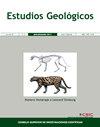Pedregal花岗岩(葡萄牙):一种特殊花岗岩类的岩石学和地球化学特征
IF 0.8
4区 地球科学
Q3 GEOLOGY
引用次数: 3
摘要
葡萄牙北部伊比利亚中部的Pedregal花岗岩露头,位于同生variscan花岗岩-混辉岩杂岩的东部边界,与区域变质构造亚协调。花岗岩类(约3 km2),呈NW-SE细长状,侵入星闪岩-云母岩和带状片麻岩-混辉岩中,接触处局部有火成岩角砾岩。区内岩石属伊迪加里世—寒武系变质长岩—变质岩层序,称为“西斯托—格罗瓦基科杂岩”(CXG),主要为NW-SE ~ NNW-SSE方向的区域性片理。Pedregal花岗岩为过铝质花岗岩(A/CNK参数范围为1.18 ~ 1.62),具有镁质和碱-碱-钙特征。花岗岩的特征是高Zr含量(389 ~ 435 ppm)和低稀土元素(LREE)扁平模式,这是花岗岩中不常见的特征,而且黑云母的腐蚀形状和大量的次生白云母。这些奇特的特征使其区别于邻近的同生花岗岩。Pedregal花岗岩的场场、岩石学和化学特征符合残渣部分熔融的第二阶段,在第一次熔融过程中被熔体偏析耗尽,其中包晶石榴石和丰富的残黑云母与含LREE和zr的副矿物有关。此外,花岗岩的侵入特征和变质沉积岩包体的存在表明其为次生闪长岩。本文章由计算机程序翻译,如有差异,请以英文原文为准。
El granito de Pedregal (Portugal): caracterización petrográfica y geoquímica de un granitoide peculiar
The Pedregal granite outcrops in the Central Iberian Zone, northern Portugal, in the eastern border of a synorogenic variscan granite-migmatite complex sub-concordant with the regional metamorphic structures. It is a granitoid (ca. 3 km 2 ) with an elongated NW-SE shape intruded in staurolite-micaschist and banded gneiss-migmatite rocks, with local igneous breccias in the contact. The country rocks belong to a metapelitic and metasammitic sequence of Edicarian-Cambrian age, known as the “Complexo Xisto-Grauvaquico” (CXG) which shows a main regional foliation with a NW-SE to NNW-SSE direction. The Pedregal granite is peraluminous (its A/CNK parameter ranges from 1.18 to 1.62), with a magnesian and alkali to alkali-calcic signature. The peculiar features of the granite are high contents of Zr (389 to 435 ppm) and a LREE flat pattern, which are uncommon characteristics for granitic rocks, as well as the corroded shape of the biotite, and the large amount of secondary muscovite. These peculiar features distinguish it from the adjacent synorogenic granites.
The field, petrographical and chemical features of the Pedregal granite are in accordance with a second phase of partial melting of a residuum, depleted by melt segregation during a first melting episode with the involvement of peritectic garnet and abundant residual biotite with LREE- and Zr-bearing accessory minerals. Besides, the intrusive character of the granite, and the presence of metasedimentary xenoliths point out to a secondary diatexite.
求助全文
通过发布文献求助,成功后即可免费获取论文全文。
去求助
来源期刊

Estudios Geologicos-Madrid
GEOLOGY-
CiteScore
1.40
自引率
14.30%
发文量
6
审稿时长
>12 weeks
期刊介绍:
Since 1945 Estudios Geologicos publishes original research works, as well as reviews, about any topic on Earth Sciences.
Estudios Geologicos is published as one yearly volume, divided into two half-yearly issues. It is edited by the Spanish National Research Council (Consejo Superior de Investigaciones Científicas, CSIC) at the Instituto de Geociencias (CSIC-UCM).
Estudios Geologicos provides free access to full-text articles through this electronic edition. Accepted articles appear online as "Forthcoming articles" as soon as the galley proofs have been approved by the authors and the Editor-in-Chief. No changes can be made after online publication.
 求助内容:
求助内容: 应助结果提醒方式:
应助结果提醒方式:


